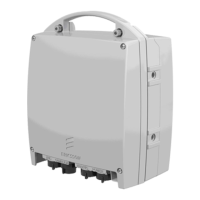6-11 MINI-LINK BAS
EN/LZB 111 0542 P2B Technical Description
HP OV GUI Display
Basic Platform
Alarm
and
Event
Application
2. Each
application
is started
list of
applications
installed
1.
4. Each
application
subscribes
to basic
platform
7. alarm appl.
retrieves current
alarm list and
ordes that
current alarm
list be
displayed
3. Erlange process created
at start by alarm appl.
and waiting for event
messagges from the
basic platform. This process
id. is sent to the basic
platform in the subscription
call.
5. operator
selects option to
view current
alarms.
Operator
6. All applications
informed of operator
event.
Figure 6-6 Basic Platform
Figure 6-6 is an example clarifies how the basic platform architecture
works.
1. Upon start-up, the basic platform reads a file listing the
applications that have to be started installed.
2. The basic platform starts the applications listed in the above
mentioned file.
3. All applications initialise an internal Erlang process whose
purpose, which is to receive event messages from the basic
platform.
4. The application sends a subscription message to the basic platform,
carrying the PID of the process to which all event messages have
to be sent by the basic platform.
5. Now suppose that, once the system is up and running and therefore
all applications have been correctly started, the operator selects a
menu option, requiring the system to display the list of current
alarms. The request is intercepted by the basic platform that
converts it to an event message.
6. The event message containing the operator request is forwarded to
all applications, but only those that are interested in the event will
manage it.
7. The alarm application retrieves the list of alarms and asks the basic
platform to display them onto the screen.

